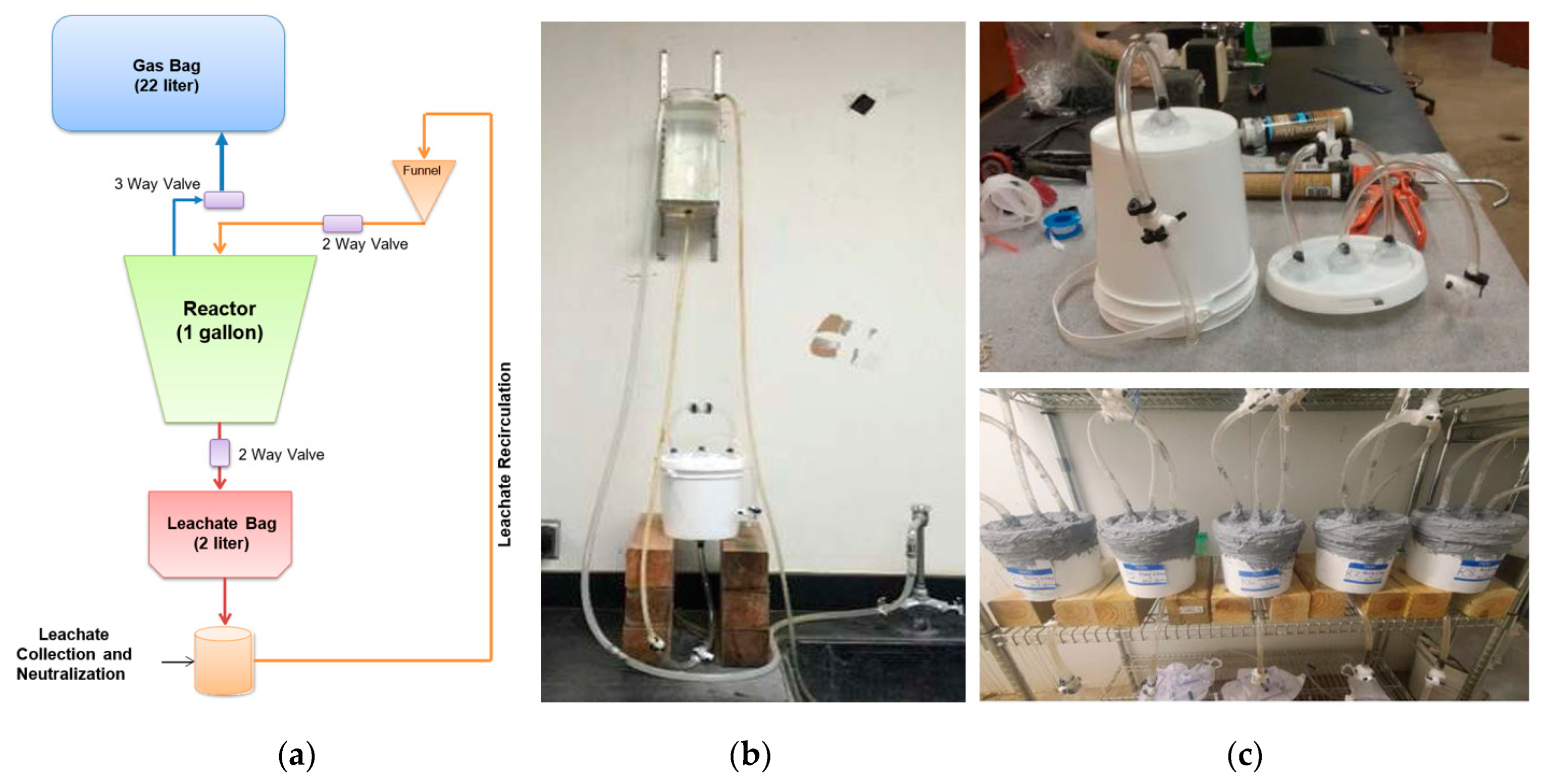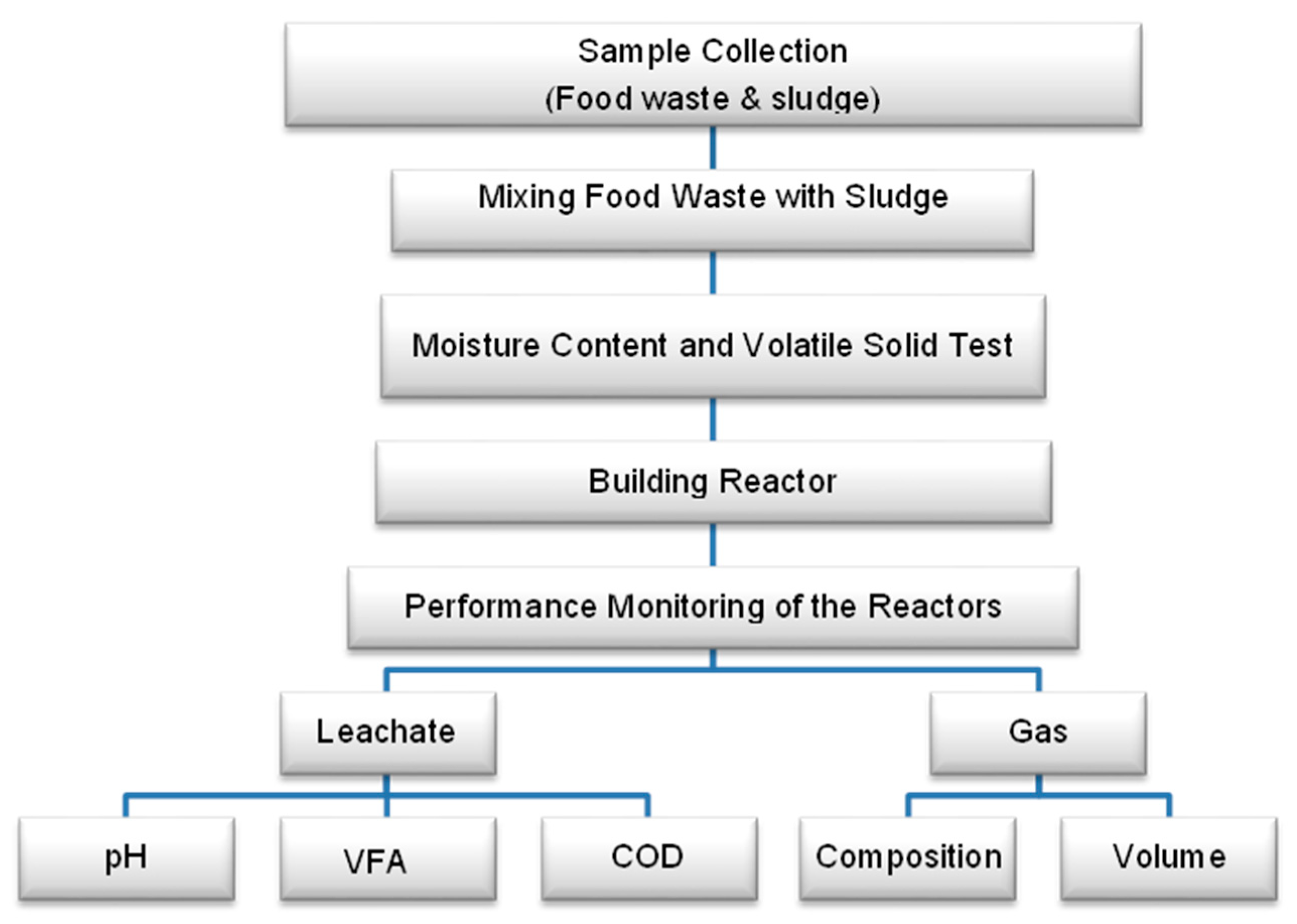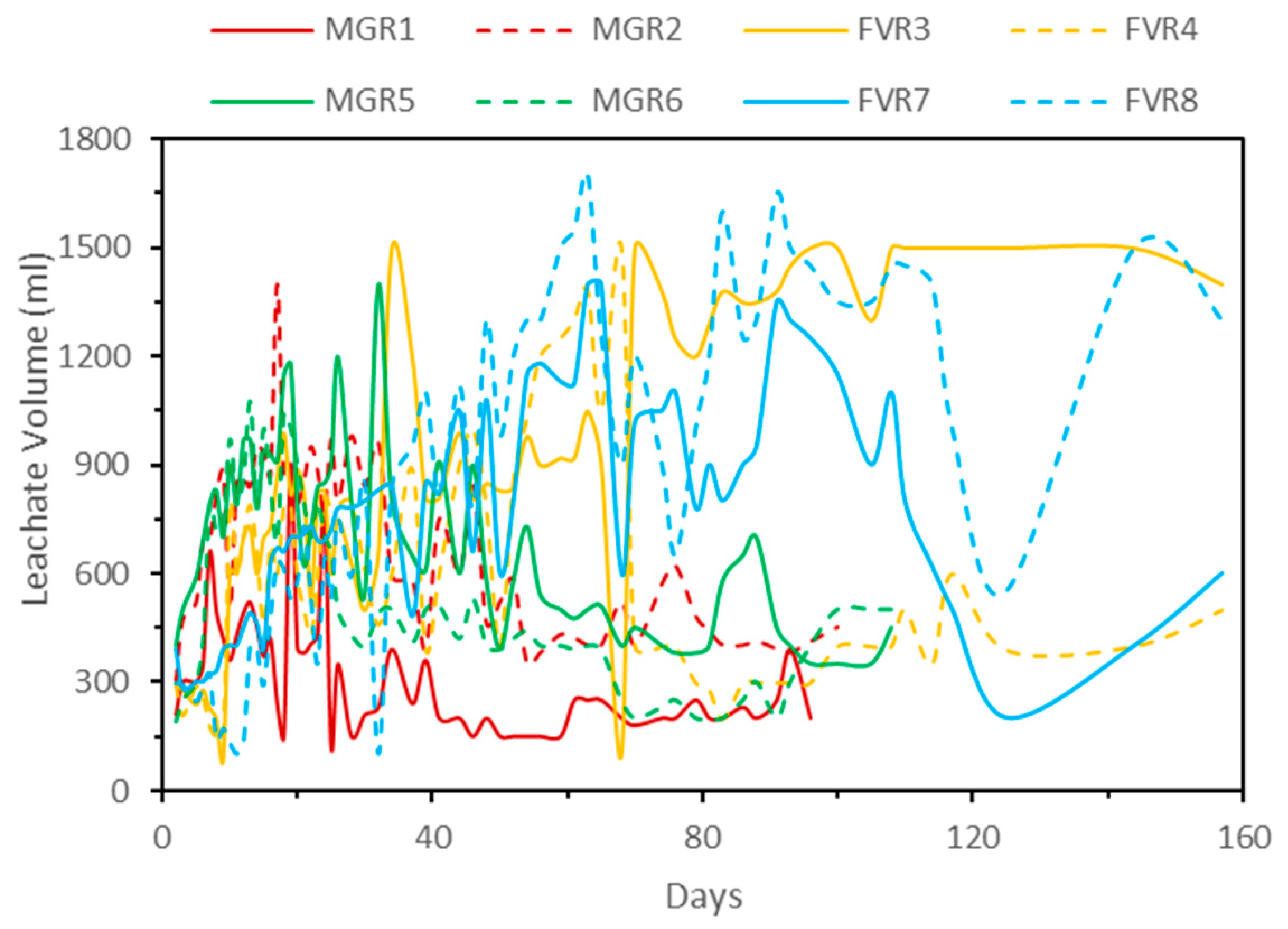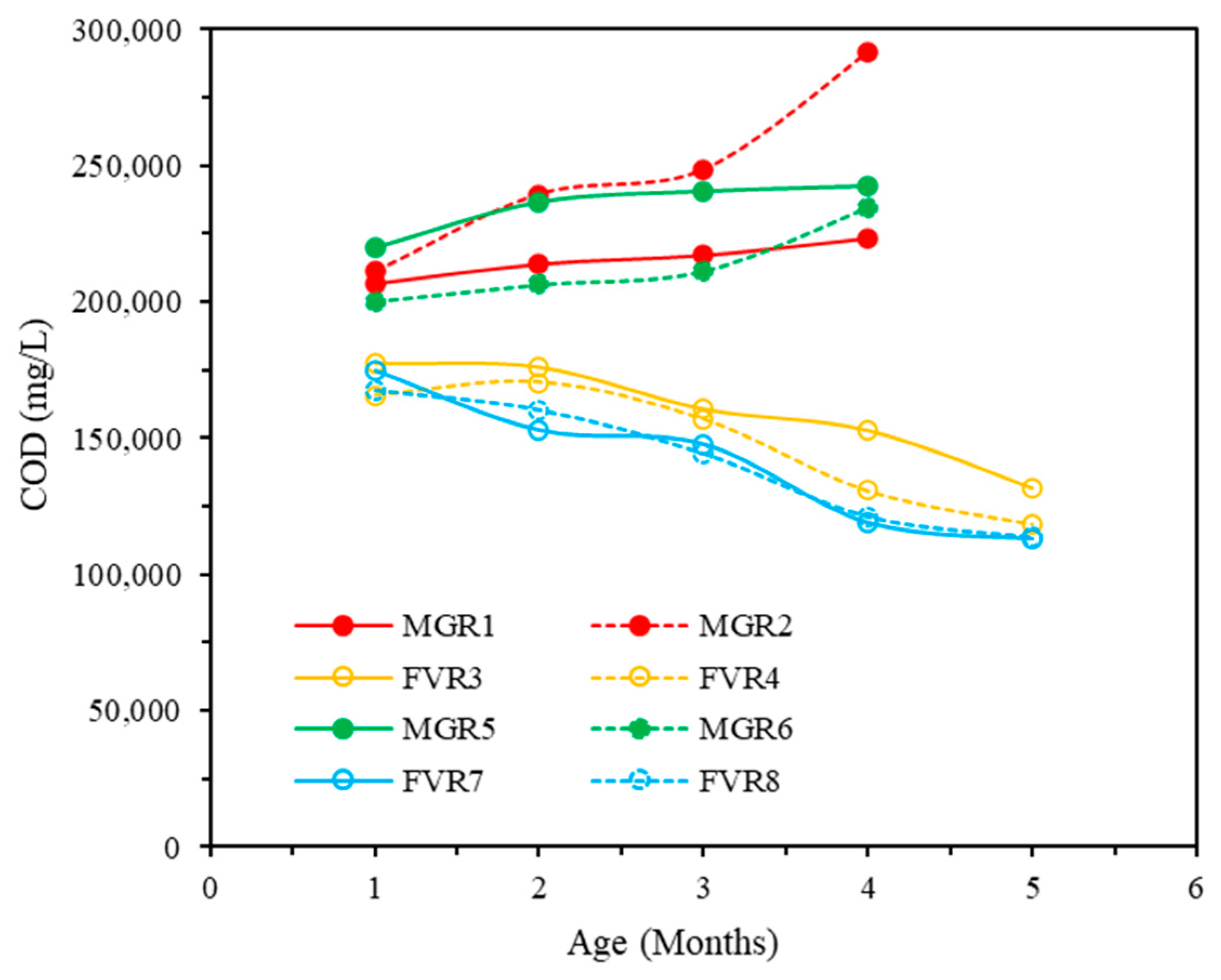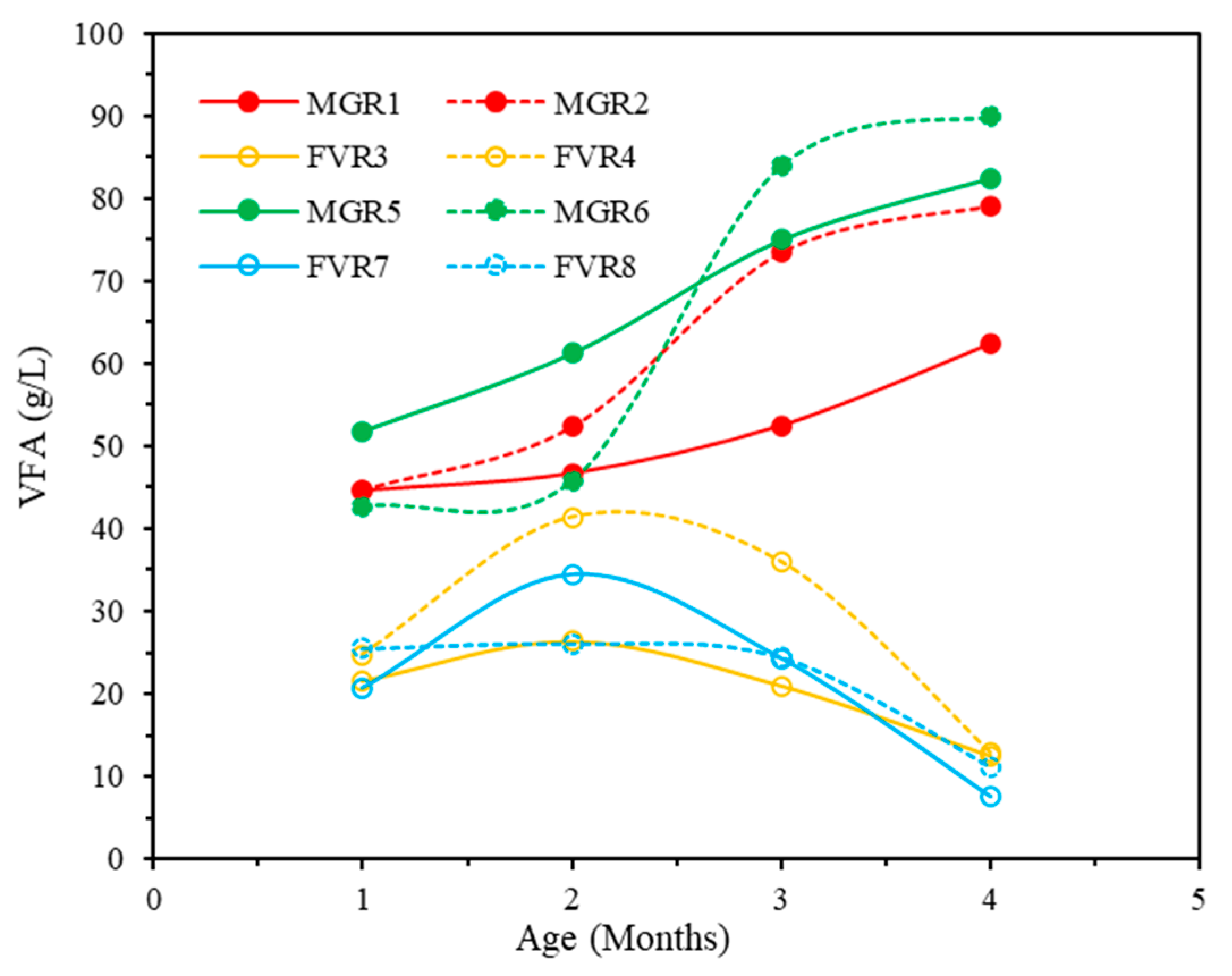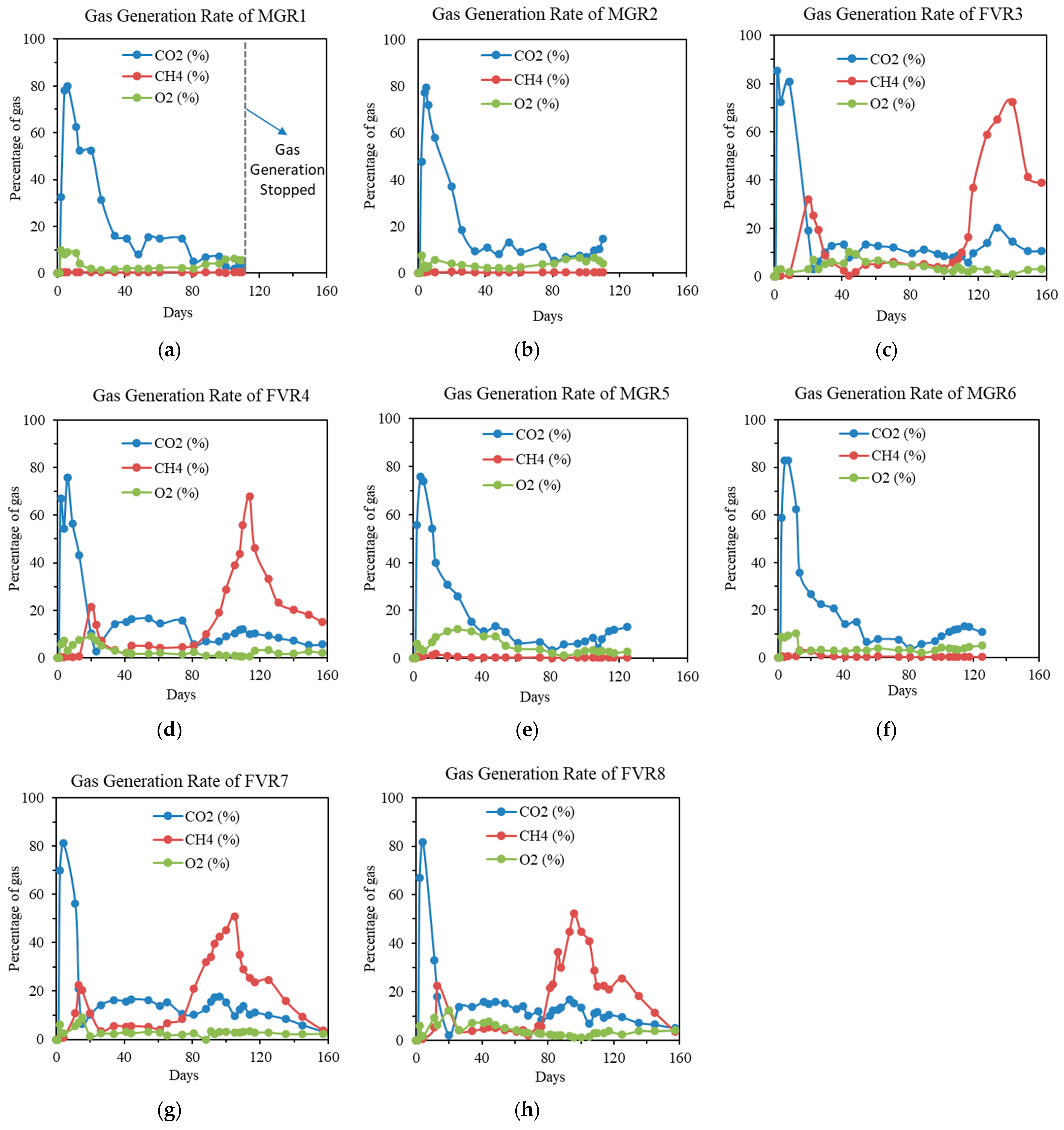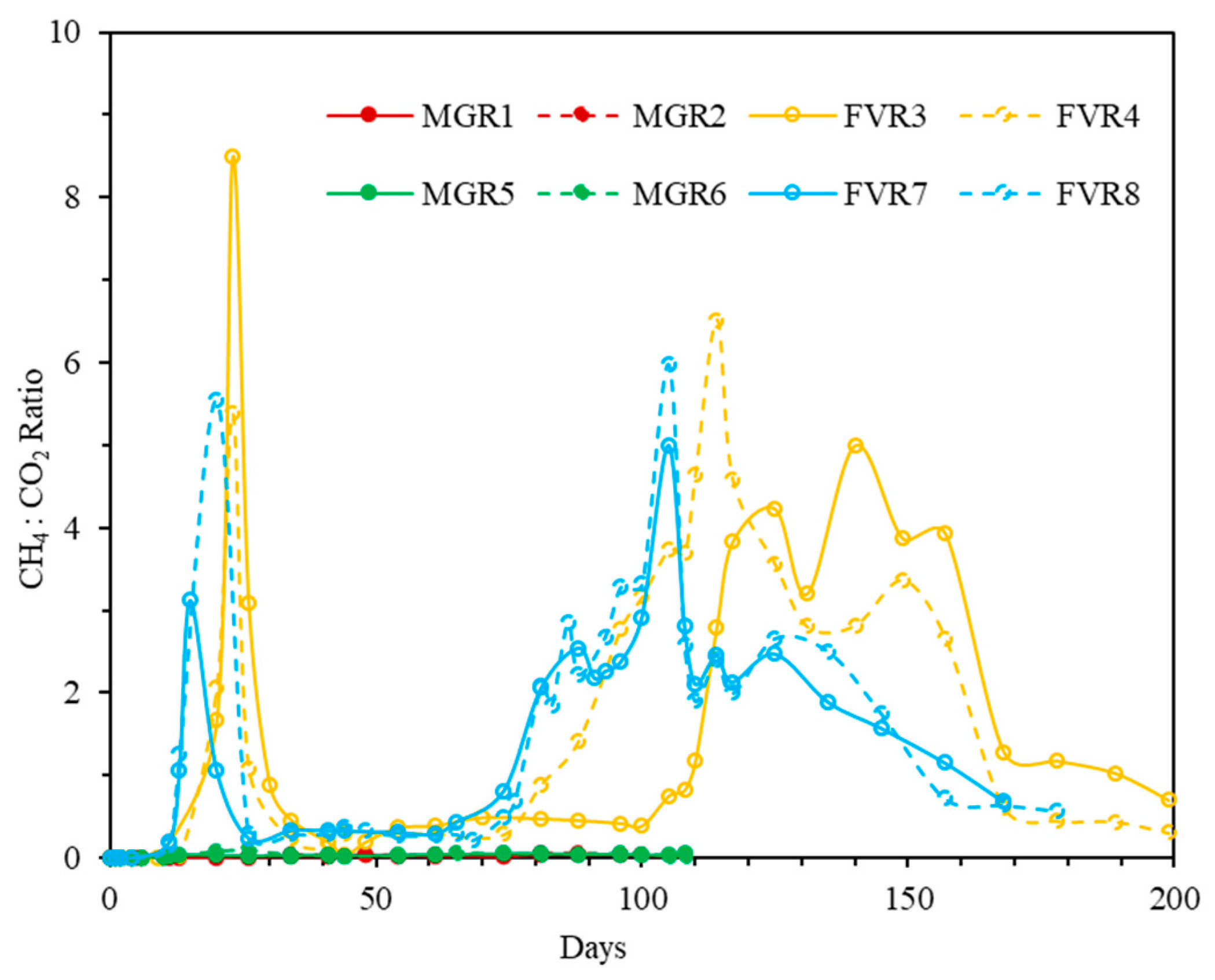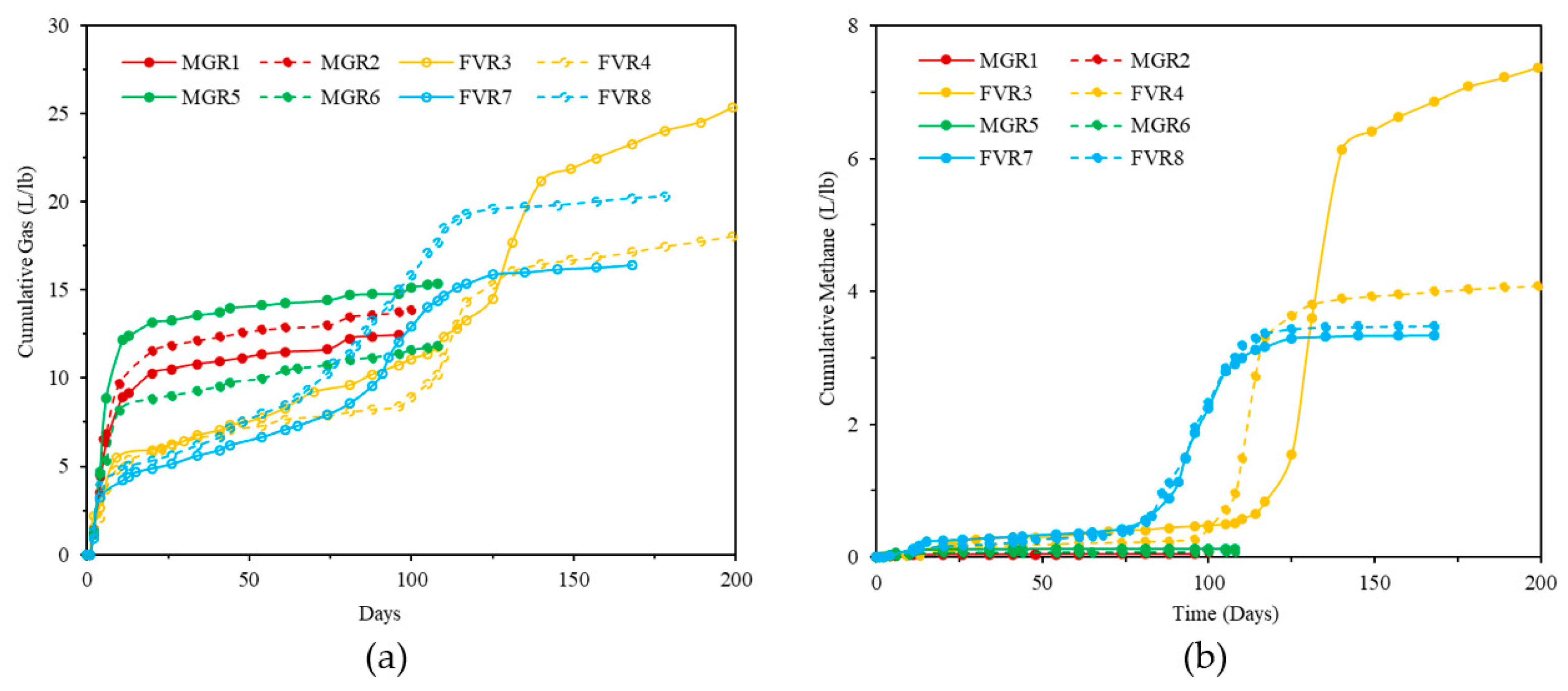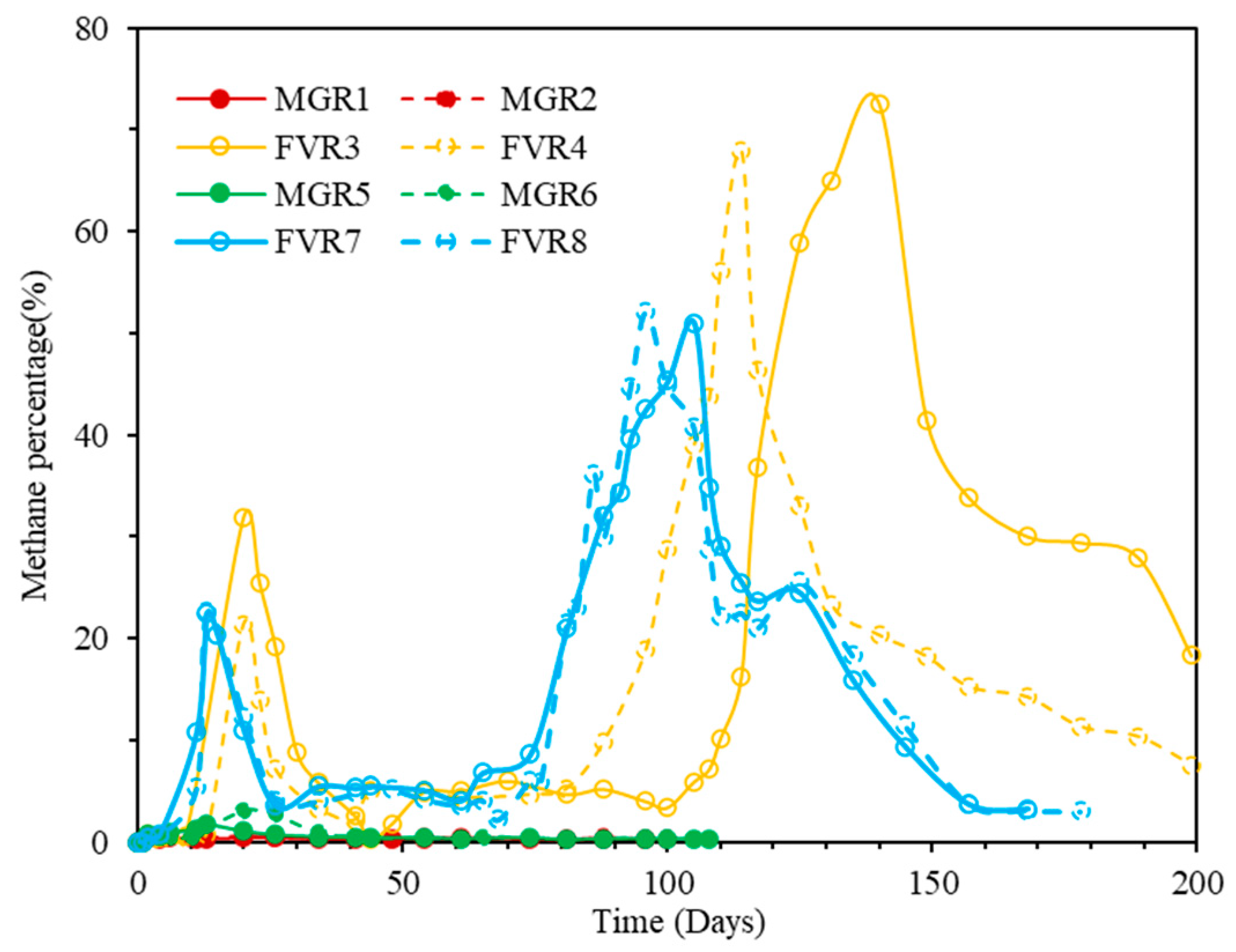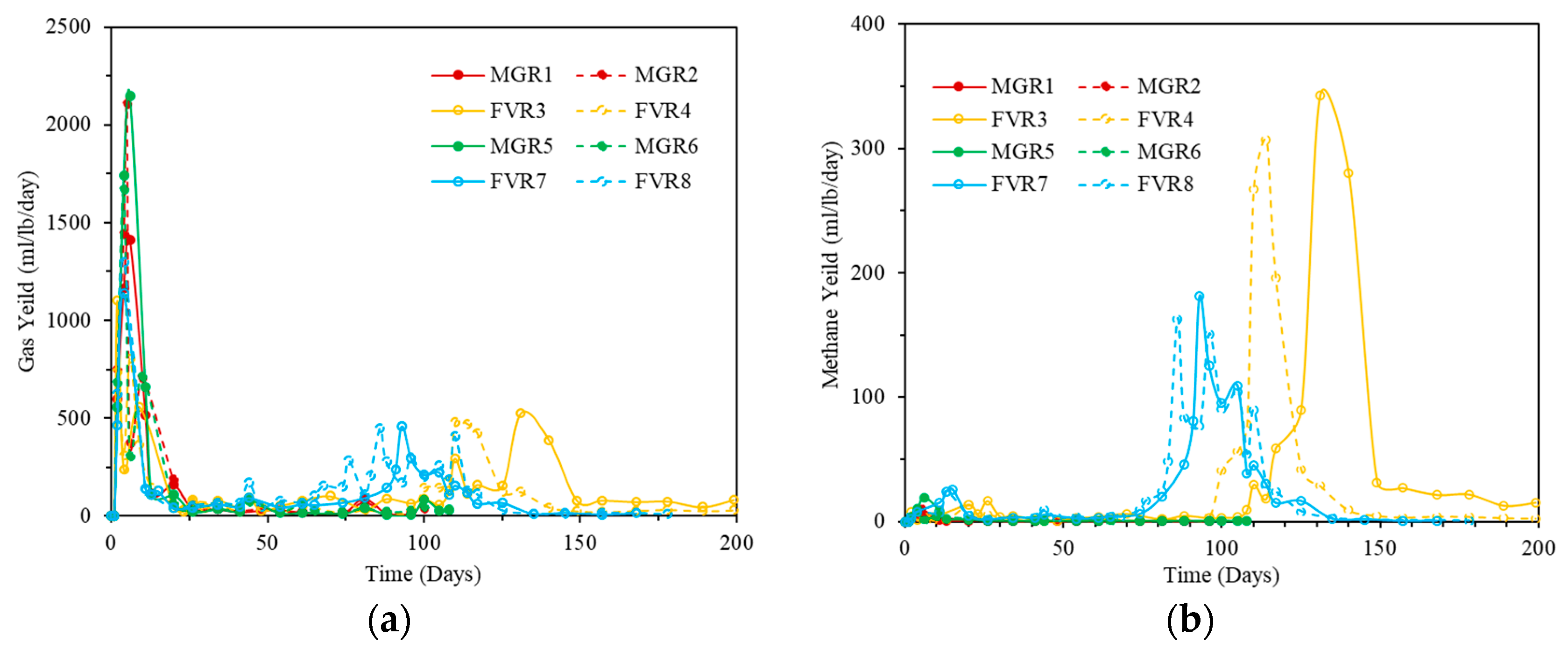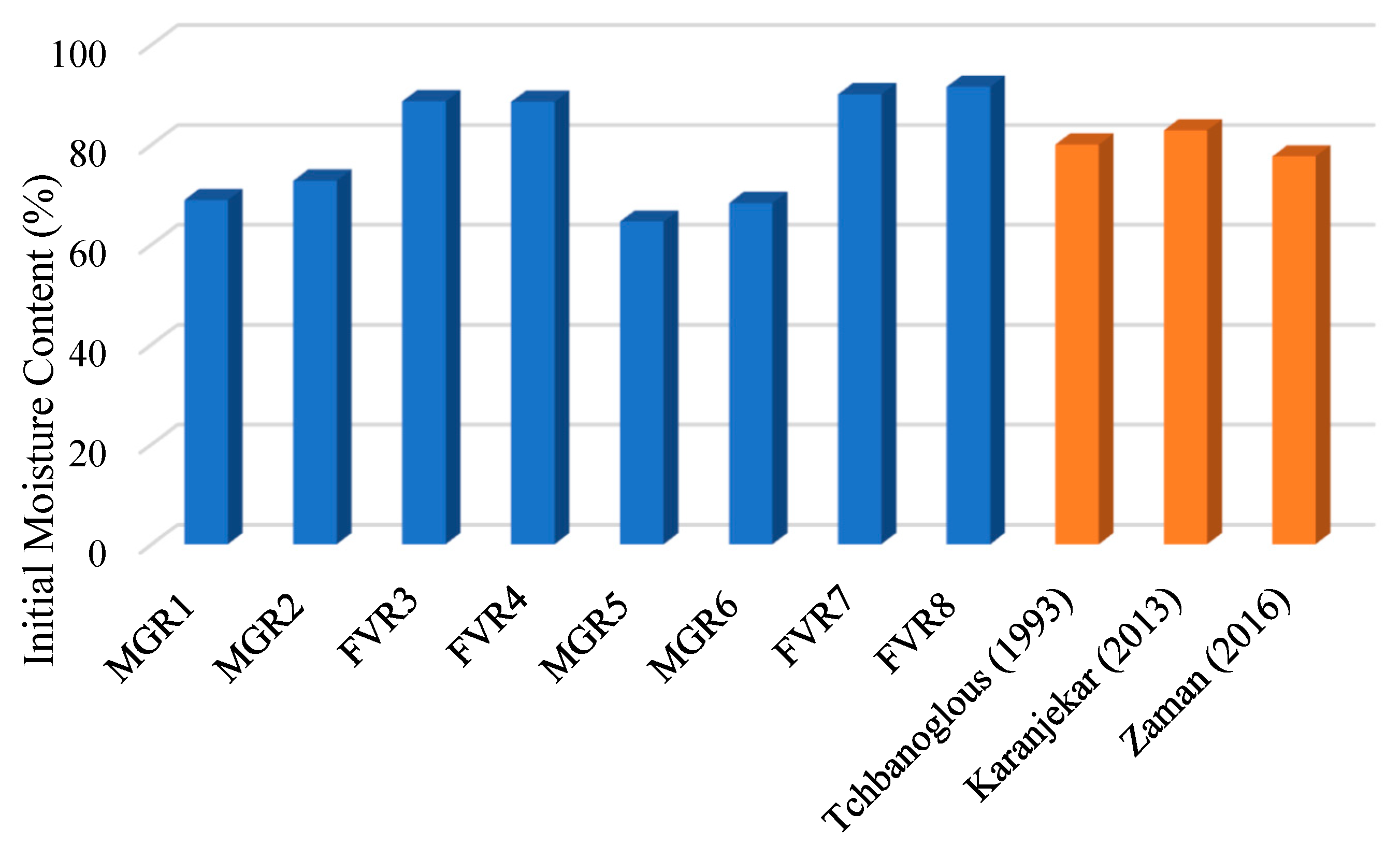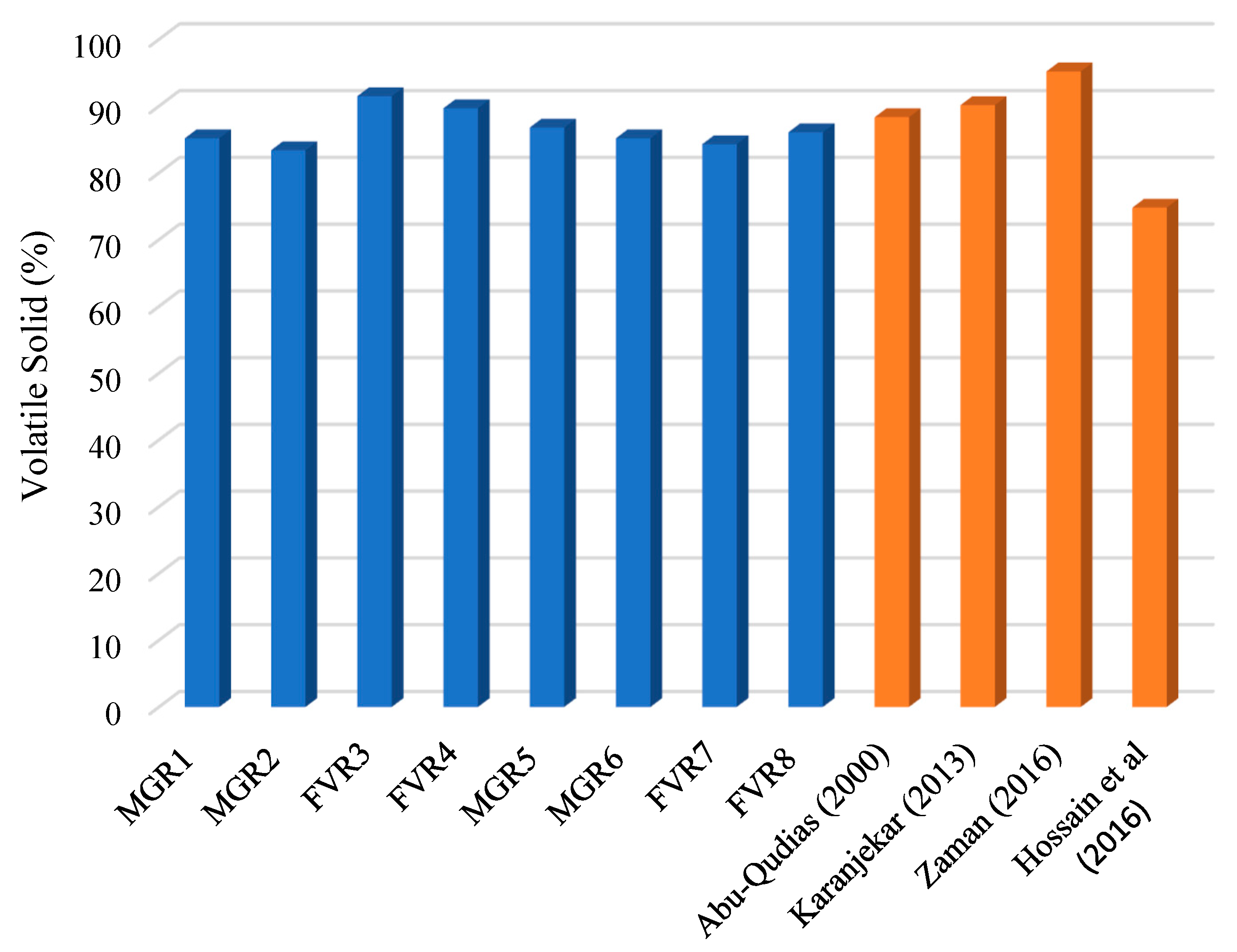1. Introduction
Food waste has become a serious issue which has increased with the world’s expanding population [
1]. According to the Food and Agriculture Organization (FAO) [
1], food waste is the edible part of the produced consumables that, instead of being consumed, is either discarded, lost, degraded, or affected by pests. Globally, around one-third of the edible parts of food produced for human consumption is lost or wasted, which is about 1.3 billion tons per year [
1]. Food waste is reported to be the second-largest component (14–21%) of the waste stream in the USA [
2,
3]. According to the US Food and Drug Administration, food waste is estimated at between 30–40 percent of the food supply in the United States [
4]. The regional per capita food loss is as high as 650 lbs per capita per year in North America & Oceania, and the lowest amount is 276 lbs per capita per year in South & Southeast Asia [
1].
In medium- and high-income countries, food is wasted to a great extent. Significant food loss occurs early in the food supply chain. In low-income countries, food is mainly lost during the early and middle stages of the food supply chain; much less food is wasted at the consumer level. In developing countries, these food wastes are the largest portion of municipal solid waste, which is approximately 70% of the waste stream [
5].
Food waste is becoming a major concern in all sectors, especially from the economic and health perspective. The biggest challenge that remains in reducing food waste is to identify and quantify the point(s) where food loss occurs in the food system. However, reducing food waste is not easy and requires immense planning and implementation. Hence, food waste finds its way into landfills before being diverted as animal feed, composting, incineration, and anaerobic digestion (AD). Incineration is not very popular for food waste diversion because of its extremely high moisture content. The presence of excessive moisture demands higher energy for incineration.
Food waste harms the environment through excessive methane generation and leachate production. Besides, food loss accounts for significant economic loss in both developed and developing countries. However, food waste can be used for composting or converted to energy if diverted from the main waste stream. Many US states have already begun food waste diversion and using this organic waste in composting or in anaerobic digesters for energy production.
Anaerobic digestion (AD) is a microbiological process whereby organic matter is decomposed in the absence of oxygen via enzymatic and bacterial activities which produce biogas that could be used as a renewable energy source [
6,
7]. This process is common in many natural environments such as swamps or stomachs of ruminants. In order to produce biogas using an engineered approach and controlled design, the AD process is applied to process organic biodegradable matter in airproof reactor tanks, commonly named digesters. The anaerobic digestion of food waste transforms this organic waste material into valuable energy resources while, at the same time, reducing solid waste volumes and, thus, waste disposal costs. Biogas as a renewable energy source not only improves the energy balance of a country but also contributes to the preservation of natural resources and environmental protection by reducing waste pollution and the usage of fossil fuels [
8].
In developing countries, more than 70% of the MSW is food waste which contains a significant amount of moisture (70~90%) [
9]. Developing countries do not have a well-built infrastructure for the proper collection and disposal of waste. Most of this food waste ends up in open dumps due to a lack of proper collection and disposal of waste. This uncontrolled dumping of food waste leads to the contamination of water sources and contributes to greenhouse gas emissions, having high methane generation potential [
9].
Being the wettest portion of the waste stream as well as having a high amount of volatile solids, this food waste can be utilized as a potential energy source and reduce the consumption of non-renewable energy sources. Moreover, anaerobic digestion of this food waste can reduce extreme environmental hazards related to landfilling, which is the least preferred option. Therefore, the anaerobic digestion of food waste has substantial potential to be exploited as a sustainable waste management technique alongside being a considerable replacement for fossil fuel as an energy resource.
Approximately 90% of rural households in developing countries are still dependent on natural biomass fuels for cooking and heating (wood, dung, and crop residues), which are typically burnt in ineffectively functioning stoves or open fires indoors [
9]. In the presence of poor ventilation, this combustion process is fragmented in most cases, which results in significant emissions and produces very high levels of indoor pollution [
10,
11]. Women’s exposure to emissions is much higher than men’s, as cooking, customarily, has become a primary involvement for women in developing countries [
12,
13]. The exposure to benzo[a]pyrene, which emits from stoves for cooking, for around three hours a day can be compared to smoking two packets of cigarettes daily [
11].
Thus, biogas produced from an anaerobic digester designed to fulfill the cooking demand of a household can significantly eliminate these adverse effects on the environment and human health. Besides, it can be a great source of renewable energy and can reduce dependency on fossil fuels and related expenditures. However, one of the major problems of organic waste is its high C:N ratio, since it is very acidic in nature [
14]. Therefore, the mono digestion of food waste can lead to the inhibition of microbial activities and thus impede biogas production. Furthermore, finding an acceptable, economical, and readily-available inoculum in developing countries is also a vital step. Though human feces have significant potential for use as inoculum, the usage of biogas produced from it was refused in Dar es Salaam, Tanzania [
7]. Moreover, some enzymes have the exclusive ability to break down lignin; however, they can never be used because of their high expense. The anaerobic co-digestion of sewage sludge and other organic waste is an attractive method for both waste treatment and biogas production [
15].
Excessive volatile fatty acid (VFA) accumulation takes place at the early stage of food waste decomposition and creates a lag phase for methane production (Shao et al., 2005). Wang et al. (1997) successfully reduced this lag phase for pure food waste by using a high percentage of inoculum. However, no prior research has been conducted to identify the individual components of food waste responsible for this early lag phase of decomposition. Furthermore, limited studies are available for evaluating the effect of sludge on gas generation along with different food wastes. Therefore, in this study, various combinations of individual food waste components were considered to detect the components responsible for the early lag phase. In addition, the percentage of sludge as inoculum in these combinations was also varied to obtain the most effective combination of food waste and sludge. Thus, this study aims to propose an effective combination of food waste and sludge so that it can be implemented in developing countries with locally-produced food waste. An extensive experimental program was prepared to evaluate the results collected from gas and leachate generation data.
The successful design of a household or community-level anaerobic digester will help to significantly reduce the harmful effects of food waste on human health and the environment, and will ensure a renewable energy source and curtail the need for fossil fuel. The outcomes of this research will provide some good productive data for constructing an efficient and cost-effective underground AD for rural households in developing countries.
2. Materials and Methods
The main objective of this study is to investigate the effect of different percentages of sludge content on the degradation of different types of food waste through the laboratory simulation of an anaerobic digester operation. This study is aimed at determining the most suitable combination for maximum gas generation from food waste AD.
An experimental program was undertaken to simulate eight laboratory-scale food waste ADs with two different percentages of sludge and four types of food waste. The reactors were monitored daily, and the leachate and gas generated from the reactors were collected and tested periodically. Volatile solids, total solids, Volatile Fatty Acid, and COD tests were also conducted to observe the stage of biodegradation in the laboratory. The following subsections discuss the experimental design and test procedure for the reactor operations.
2.1. Experimental Design
2.1.1. Inoculum Percentage
Food waste itself does not have a considerable number of microorganisms in it. Thus, to ensure microbial population, sludge was chosen as inoculum. Two different percentages of sludge were used for four pairs of the reactor. For the first two pairs, sludge was 20% and, for the last two pairs of the reactor, sludge percentage was 30%. This percentage was chosen based on availability and applicability in both developed and developing countries [
9].
2.1.2. Waste Composition
Observing the food waste scenario of south Asian countries, the waste composition was determined. Generally, fruits and vegetables are also produced in significant amounts in developing countries followed by dairy products, meats, and fish. Considering this production scenario, two combinations of food waste were decided on for use in the bioreactor: grain-meat and fruit-vegetables. Food waste was collected from the UTA connection café and UTA compost center.
2.1.3. Bioreactor Combinations
Laboratory-scale simulated food waste ADs were built to analyze the effect of sludge on food waste decomposition and gas generation. Sludge was added to all sets of ADs as a source of microorganisms. A total of four pairs of ADs were built, of which two pairs were made of meat and grain, with sludge contents of 20% and 30%, respectively. Another two pairs were fruits and vegetables, with 20% and 30% of sludge, respectively. All the ADs were filled with about three and a half pounds of food waste mixture.
Table 1 shows the combinations of the reactors.
It was necessary to operate the reactors in anaerobic environmental conditions and, at the same time, provide a proper leachate collection and recirculation system and gas collection system. For this reason, an appropriate reactor setup was designed as shown in
Figure 1.
ADs were kept in an environmental control chamber at a temperature of 37 ± 1 °C for faster degradation of the food waste. For evaluating the leachate quality, pH, VFA, and Chemical Oxygen Demand (COD) were measured regularly. Depending on the gas generation, gas composition and gas volume were measured. A summary of the experimental workflow is presented in
Figure 2.
2.2. Sample Collection & Storage
Food waste was collected from two sources:
Fruits and vegetables were collected from the University of Texas at Arlington (UTA) Compost Center.
The meat and grains from the lunch buffet in the University Center dining area (Connection Café) at the UTA.
Approximately 20 pounds of food waste was collected from the café, which contained meat and grain products (rice, noodles, pasta, bread, etc.). The collected samples were brought to the laboratory and stored at 4 °C in the environmental growth chamber to preserve their original properties before building the reactors. Sludge was collected from Village Creek Water Reclamation Facility, Fort Worth, Texas, and was added to the reactors as a micro-organism source.
2.3. Laboratory Scale Simulated AD Setup & Monitoring
2.3.1. Preparation of Laboratory Scale AD
Laboratory scale ADs were built in one gallon smart-seal, leak-tight HDPE buckets (United States Plastic Corporation, Lima, OH, USA), modified (according to design) for gas and leachate collection and leachate recirculation. A total of eight reactors were prepared in pairs of four combinations.
Leak tests were conducted to make sure that there were no leaks present in the AD (
Figure 1b). The lids were sealed with silicon sealant and filled with water from the overhead tank through the base of the AD. All valves at the top plate were kept closed. The pressure was developed inside the bucket due to the head difference in water from the overhead container. The leak tests confirmed there were no leaks on the AD, since the water level in the manometer showed no significant changes. Once the AD passed the leak test, the reactors were filled with food waste. Sludge was added to the waste as nutrients. Since the food waste had high moisture (more than 70%), rather than adding water at the beginning of the operation, it was allowed to drain excess moisture for the first couple of days.
Waste was filled up to a level to allow sufficient space (1.5 inches from the top) for gas to freely escape to the gas bag through the gas outlets. After being filled with food waste, the lids of the reactors were closed and sealed with silicone sealant to make them airtight and leakproof. Once the sealing was done, the gas collection and leachate collection bags were connected to each AD and placed in the environmental growth chamber at 37 °C (
Figure 1c).
2.3.2. Properties of Food Waste
The moisture content of the food waste samples was measured on a wet-weight basis. Approximately 900 gm of samples were collected from each pair of AD. The samples were dried for 5 to 7 days until a constant weight was achieved at 65 °C (±5 °C) in the oven and were measured for moisture loss. Extra care was required to find the moisture content of the waste (food waste), as it was reported that organic matter from food waste volatilizes at high temperatures (105 °C for MSW) [
16].
The volatile solids (VS) measurement followed a modified version of Standard Methods, the APHA Method 2440-E. For vs. determination, the first samples were oven-dried at a temperature of 65 °C (±5 °C). Dried samples were then cut into smaller pieces. About 50 g of sample were measured in a porcelain crucible. The sample was placed in the muffle furnace at 550 ± 10 °C for about two hours and burnt completely to ashes. The volatile organic content was determined from the percentage of weight loss.
2.4. Operation and Monitoring of Reactors
A routine operation and monitoring of the AD included collection and recirculation of leachate and collection and measurement of the gas generated. Food waste has a high moisture content (almost 70 percent or more). Hence, after setting up the AD, no moisture was added for a couple of days; instead, the digesters were allowed to drain excess moisture as leachate. During the operation, in the beginning, collected leachate was recirculated in the respective reactors every day. A graduated conical flask was used to measure the leachate’s volume before recirculation. KOH buffer was used as needed to neutralize (pH ≈ 7) the leachate to be recycled.
During the AD operation, generated gas was collected in Cali-5-BondTM 22-L gas bags. Gas was collected and measured regularly whenever a considerable amount of gas accumulated in the bag. Landtec GEM 2000 PLUS with an infrared analyzer was used for measuring the concentration of methane (%CH4), carbon dioxide (%CO2), oxygen (%O2), and other gases (%BAL) in the gas bags. To measure volume, gas was pumped out of the bag using a standard SKC grab air sampler (SKC Aircheck sampler model 224-44XR) connected to a calibrator (Bios Defender 510) which gives a fixed flow rate. Using a stopwatch, the time for emptying the gas bag was measured and the total volume was found.
The pH of the generated leachate was measured with the help of a bench-top Oakton pH meter. To ensure precise pH reading, the pH probe was calibrated by a three-point calibration method (pH 4.00 ± 0.01, 7.00 ± 0.01, and 10.00 ± 0.01) using buffer solutions. In between taking pH readings, the probe was washed under flowing water and rinsed with deionized water. It was necessary to keep the probe always dipped in a buffer solution of pH 7.0. Leachate was neutralized to pH 7.0 before recirculation using a KOH buffer solution.
Chemical Oxygen Demand (COD) tests were performed on a monthly basis. For each reactor, two tests were conducted by diluting the leachate in a 1:100 ratio. Samples were prepared by pouring 2.5 mL of diluted leachate into COD vials and placing them in the digester which was previously heated to a temperature of 150 °C and keeping them in the digester for two hours. After digestion, the vials were kept outside the digester to cool them down to room temperature. The vials were then placed inside a spectrophotometer (Spectronic 200+; Thermo Fisher Scientific Inc., Waltham, MA, USA) which determines the absorbance of light and displays an absorbance value.
Volatile Fatty Acid (VFA) tests were performed on a monthly basis. For each reactor, tests were conducted by diluting the leachate in a 1:100 ratio. The pH-based titration method [
17] was used to measure VFA. Initially, the pH of the 50-mL filtered sample was measured. Then, the pH of the sample was made to be 3.3–3.5 using H
2SO
4. Then, the sample was allowed to boil for 3 min. After cooling, the pH of the sample was adjusted to 4 and the amount of NaOH consumed for making the pH 7 was measured.
4. Conclusions
The primary focus of the research was the sustainable management of organic waste by proposing an effective combination of food waste and sludge. Thus, it could be implemented in developing countries with locally produced food waste as well as for energy retrieval from organic waste, as organic waste poses several problems in the traditional landfill.
Based on the monitoring results for 160 days, fruit and vegetable showed faster decomposition compared to meat and grain. Additionally, they produced a considerable amount of gas, since VFA accumulation was much higher for the reactors that contained meat and grain. The VFA accumulation started to increase for all of the reactors in the second month.
The reactors FVR7 and FVR8 started showing a good amount of methane generation from the fourth month, as well as the reactors FVR3 and FVR4, which did the same throughout the fifth month because their VFA reduced below 13 g/L. The maximum methane production was found in the reactors FVR3 and FVR4, at 6.7 L and 4 L of methane per pound of food waste, respectively.
For the reactors FVR3 and FVR4, the CH4:CO2 ratios increased to as high as 8.5 and 6.6, respectively, and, for FVR7 and FVR8, they increased to 5 and 5.9, respectively. For the other reactors, the CH4:CO2 ratio did not increase, as they were in the lag phase. On the other hand, the concentration of oxygen depleted rapidly and remained negligible as the ADs were operated in anaerobic conditions.
The initial gas generation rate was high for all of the reactors before they went into the lag phase. Only the reactors FVR3, FVR4, FVR7, and FVR8 crossed the lag phase and started producing considerable amounts of methane, as high as 72.5%, 68%, 52.1%, and 51% by composition, respectively.
Based on the obtained results, the use of sludge with fruit and vegetable waste might be advantageous compared to meat and grain waste for accelerated decomposition. The result of this parametric study will help decide on the combination of food waste and inoculum for future implementation of household-level ADs in developing countries. However, the results might differ from the present study since the types of food waste and sludge can vary significantly based on the location and collection methods.
Additional types of food waste combinations with different sludge percentages need to be studied in the future. As ADs with 30% sludge produced better results compared to ADs with 20% sludge, further studies can be done to determine the optimum percentage of sludge by varying their percentage in a broader range. Also, sludge having a higher pH value can be used in the future to observe whether it affects the VFA accumulation rate and time.
